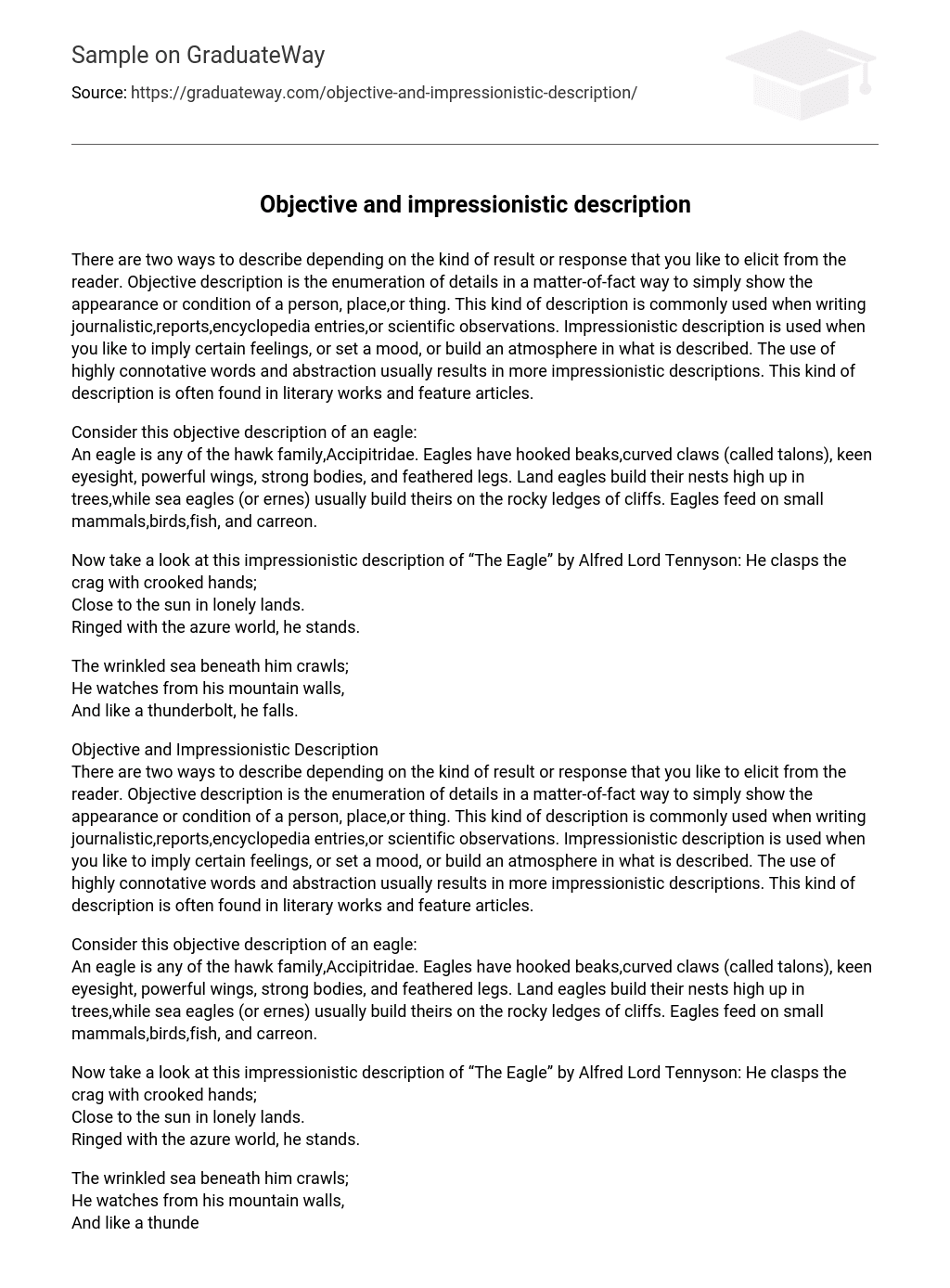There are two ways to describe depending on the kind of result or response that you like to elicit from the reader. Objective description is the enumeration of details in a matter-of-fact way to simply show the appearance or condition of a person, place,or thing. This kind of description is commonly used when writing journalistic,reports,encyclopedia entries,or scientific observations. Impressionistic description is used when you like to imply certain feelings, or set a mood, or build an atmosphere in what is described. The use of highly connotative words and abstraction usually results in more impressionistic descriptions. This kind of description is often found in literary works and feature articles.
Consider this objective description of an eagle:
An eagle is any of the hawk family,Accipitridae. Eagles have hooked beaks,curved claws (called talons), keen eyesight, powerful wings, strong bodies, and feathered legs. Land eagles build their nests high up in trees,while sea eagles (or ernes) usually build theirs on the rocky ledges of cliffs. Eagles feed on small mammals,birds,fish, and carreon.
Now take a look at this impressionistic description of “The Eagle” by Alfred Lord Tennyson: He clasps the crag with crooked hands;
Close to the sun in lonely lands.
Ringed with the azure world, he stands.
The wrinkled sea beneath him crawls;
He watches from his mountain walls,
And like a thunderbolt, he falls.
Objective and Impressionistic Description
There are two ways to describe depending on the kind of result or response that you like to elicit from the reader. Objective description is the enumeration of details in a matter-of-fact way to simply show the appearance or condition of a person, place,or thing. This kind of description is commonly used when writing journalistic,reports,encyclopedia entries,or scientific observations. Impressionistic description is used when you like to imply certain feelings, or set a mood, or build an atmosphere in what is described. The use of highly connotative words and abstraction usually results in more impressionistic descriptions. This kind of description is often found in literary works and feature articles.
Consider this objective description of an eagle:
An eagle is any of the hawk family,Accipitridae. Eagles have hooked beaks,curved claws (called talons), keen eyesight, powerful wings, strong bodies, and feathered legs. Land eagles build their nests high up in trees,while sea eagles (or ernes) usually build theirs on the rocky ledges of cliffs. Eagles feed on small mammals,birds,fish, and carreon.
Now take a look at this impressionistic description of “The Eagle” by Alfred Lord Tennyson: He clasps the crag with crooked hands;
Close to the sun in lonely lands.
Ringed with the azure world, he stands.
The wrinkled sea beneath him crawls;
He watches from his mountain walls,
And like a thunderbolt, he falls.
Objective and Impressionistic Description
There are two ways to describe depending on the kind of result or response that you like to elicit from the reader. Objective description is the enumeration of details in a matter-of-fact way to simply show the appearance or condition of a person, place,or thing. This kind of description is commonly used when writing journalistic,reports,encyclopedia entries,or scientific observations. Impressionistic description is used when you like to imply certain feelings, or set a mood, or build an atmosphere in what is described. The use of highly connotative words and abstraction usually results in more impressionistic descriptions. This kind of description is often found in literary works and feature articles.
Consider this objective description of an eagle:
An eagle is any of the hawk family,Accipitridae. Eagles have hooked
beaks,curved claws (called talons), keen eyesight, powerful wings, strong bodies, and feathered legs. Land eagles build their nests high up in trees,while sea eagles (or ernes) usually build theirs on the rocky ledges of cliffs. Eagles feed on small mammals,birds,fish, and carreon.
Now take a look at this impressionistic description of “The Eagle” by Alfred Lord Tennyson: He clasps the crag with crooked hands;
Close to the sun in lonely lands.
Ringed with the azure world, he stands.
The wrinkled sea beneath him crawls;
He watches from his mountain walls,
And like a thunderbolt, he falls.





